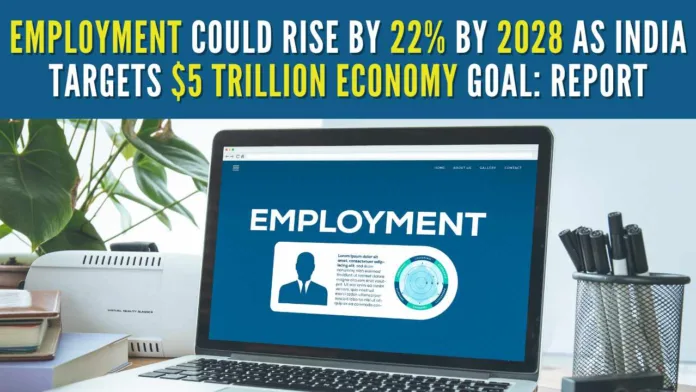
Service sector will create maximum jobs: Report
According to the ‘India Employment Outlook 2030’ report by Observer Research Foundation, as India approaches its $5 trillion economy goal, overall employment could rise by 22 percent, while unemployment could decline by 97 basis points by 2028.
The report by Observer Research Foundation, explored trends across India’s job market at a time of geopolitical churn, supply chain disruptions, and a decline in manufacturing but an explosion of services.
India’s economy could touch $5 trillion by 2026-27, driven by the pool of human capital that its young population represents, and undergirded by robust public investment and private consumption, contends the report.
It identifies sectors that the country’s 600-million-plus population of people aged 18-35 years regarded as aspirational, as these sectors could act as engines of growth in the years ahead.
The service sector in particular is set to witness significant job creation with each unit rise in services output expected to contribute to a substantial 0.12 per cent increase in employment.
The report singles out 10 especially high-opportunity sub-sectors in the services space. These include digital services, financial services, and services related to health, hospitality, consumer retail, e-commerce, and renewable energy. Other areas poised for rapid growth are global capability centers, and MSME and startup ecosystems.
The burgeoning service sector also offers encouraging avenues for women’s employment. Hence, investing in women’s skilling, financial inclusion, and entrepreneurship needs to be prioritized further, argues the report.
The projections for India’s manufacturing sector are less optimistic. In spite of the US’s growing imports from India, India’s competitive cost structures and labour resources, and the government’s push for manufacturing through flagship schemes such as Make in India, employment in the sector appears to have declined. Technological advances and increased automation continue to cast doubts upon the country’s ability to absorb its expanding workforce.
In this context, transitioning towards industrial value chains associated with the service sector could help rejuvenate employment.
Nilanjan Ghosh, a Director at ORF and one of the report’s authors says, “Policymakers and public sector schemes could partner more closely with other stakeholders to identify employability and skilling gaps. The next step would be to upgrade curricula and skills to make India’s talent pool more industry-ready.”
Ghosh added that nurturing entrepreneurship would be crucial for improved next-gen employment. “A new class of entrepreneurs could stimulate job creation, expand India’s startup ecosystem, spur innovation, and promote youth participation. But we also need to ensure that the workplaces of the future are gender-sensitive and inclusive,” he said.
The report concludes that a multistakeholder approach toward employment generation and enhancement could help realize India’s vision of a digitally empowered, skilled, innovative, and self-reliant economy.
For all the latest updates, download PGurus App.
- CM’s post in buzzing capital like Delhi not ceremonial, office holder has to be available 24×7: Delhi HC observes - April 29, 2024
- Amit Shah’s doctored video case: Delhi Police summons Telangana CM Revanth Reddy, other Congress leaders - April 29, 2024
- Smriti Irani files nomination from crucial Amethi seat; holds massive roadshow ahead of filing her nomination papers - April 29, 2024










